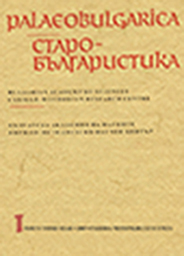Мястото, наречено Баница
The Place Called Banitsa
Author(s): Elissaveta MoussakovaSubject(s): Language studies, Language and Literature Studies
Published by: Кирило-Методиевски научен център при Българска академия на науките
Summary/Abstract: In the manuscript known as the Banitsa Gospel the colophon of the priest Ioan informs that it was completed in “St. Nicholas, in the place called Banitsa”. Benyo Tsonev suggested, mainly from philological evidence, that this allegedly detailed note refers to the village of Banitsa near Vratsa (North-West Bulgaria) and its church St Nicholas. Indeed, the scholar also considered other locations of the same name but eventually he and all other researchers after him accepted the Vratsa region as the most probable place of origin of the manuscript. What is more, certain authors ranked Banitsa as a literary centre related to the capital Tarnovo. Not only the peculiarities of the codex, but also the lack of data about any scribal activity in Banitsa or in Vratsa itself in the late thirteenth or early fourteenth century, demand an attempt to confirm or reject Tsonev’s attribution. Starting from the unclear reference “St. Nicholas” (church or monastery?), the problematic existence of either in/near the village and the Greek titles (in Cyrillic script) of two of the Gospels, the author of this paper reconsiders other possibilities to search for the manuscript’s origin: in the present-day villages Vevi near Florina and Karié near Serres, in the metochion Banitsa on Mount Athos and in the castle Banishta near Bachkovo Monastery. However, as far as sources were consulted, none of the proposed solutions proved satisfactory; so Tsonev’s arguments remain valid. What is the reason of this study, then? The reason lies in the turn of the perspective: the Banitsa Gospels should not any more be seen as an evidence for a village with scribal activity, but as a departure point towards proving the provenance and establishing the characteristics of a supposed centre. Only in this way will be substantiated either Naumov’s and Skomorokhova’s opinion of the liturgical novelty of the rubrics and the early date of the manuscript or Vakareliyska’s claim of its later composition in the mid fourteenth century and its membership in a group of Gospels preserving a remarkably archaic textological tradition.
Journal: PALAEOBULGARICA / СТАРОБЪЛГАРИСТИКА
- Issue Year: 2019
- Issue No: 1
- Page Range: 24-44
- Page Count: 21
- Language: Bulgarian
- Content File-PDF

